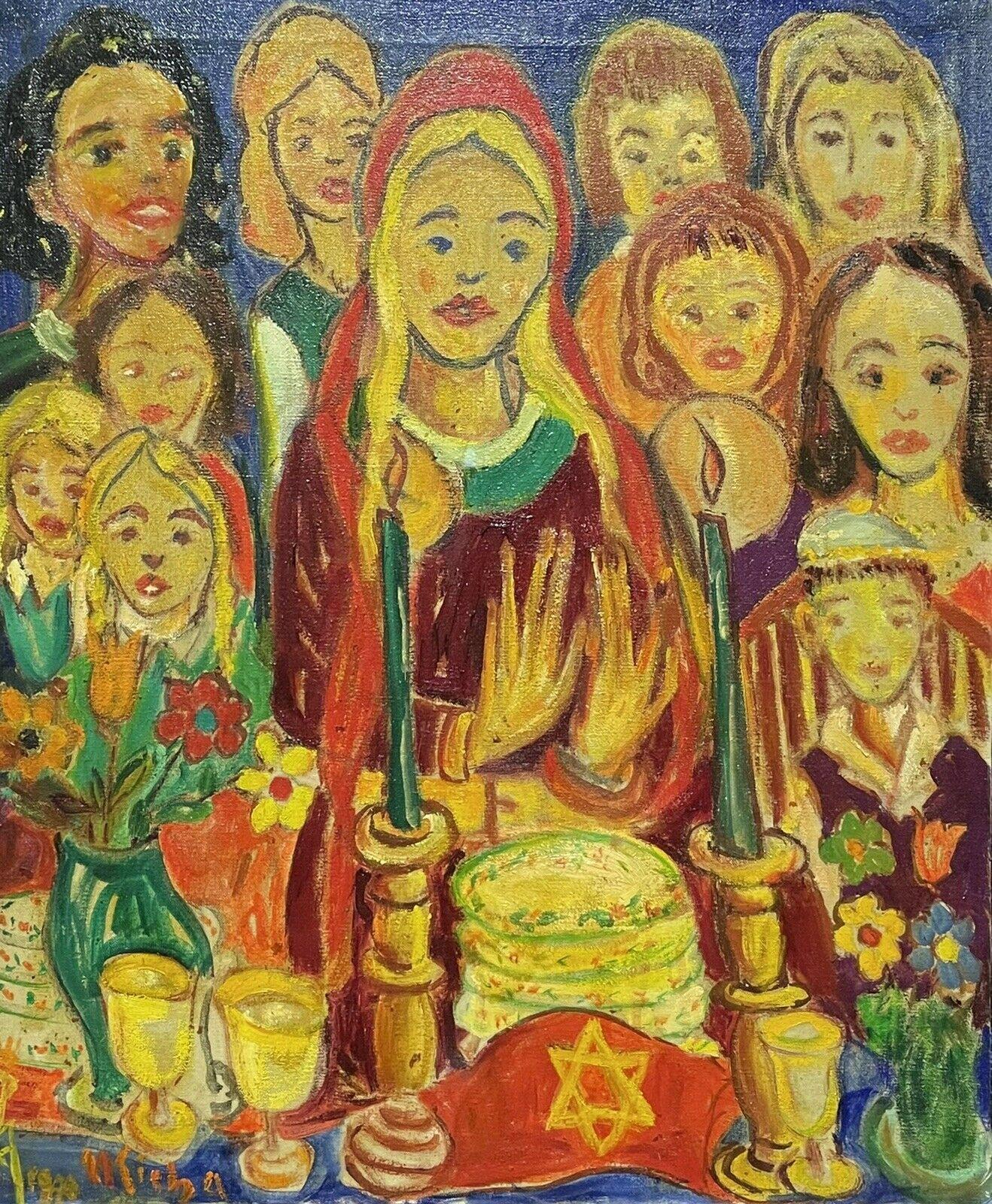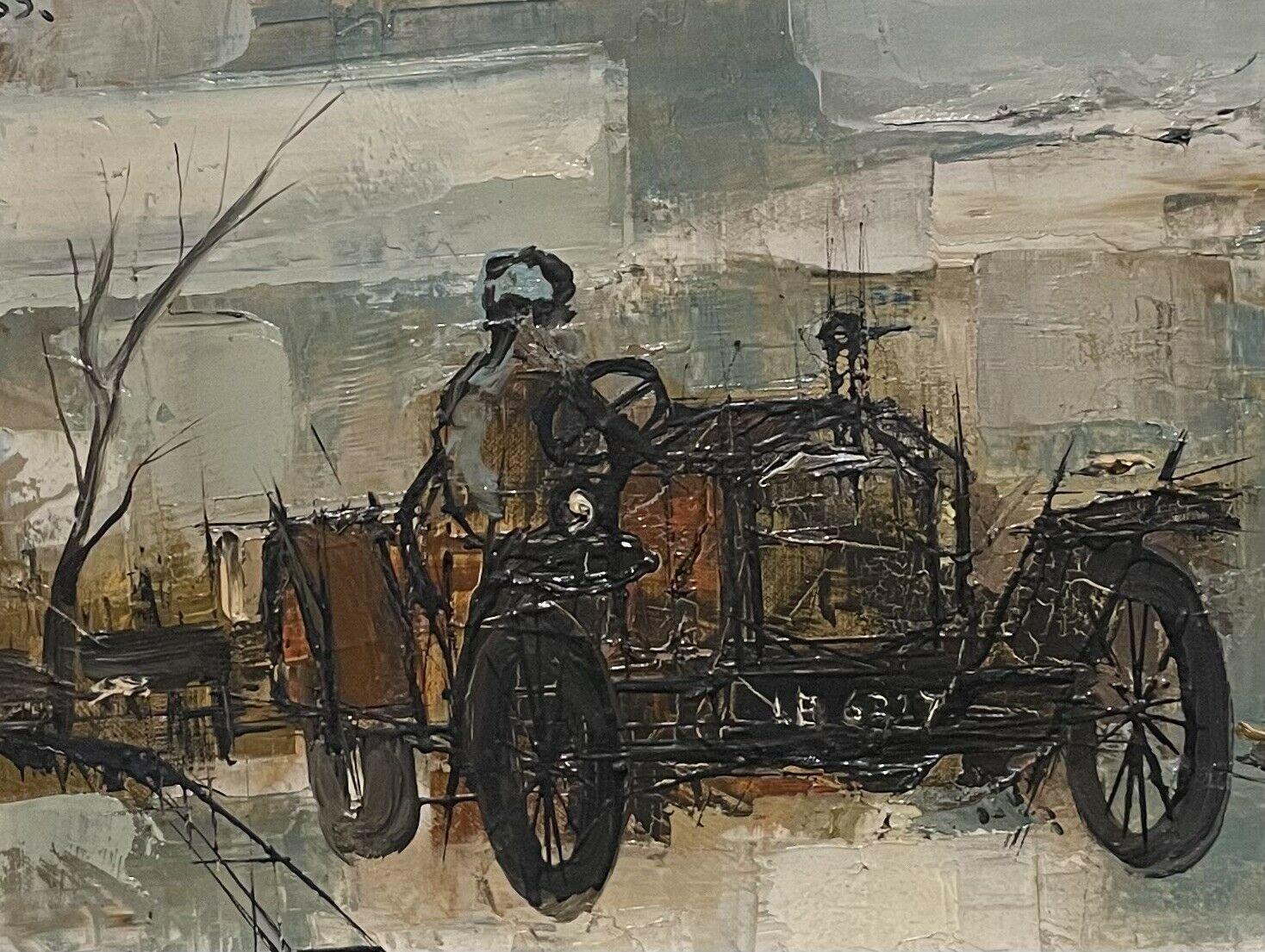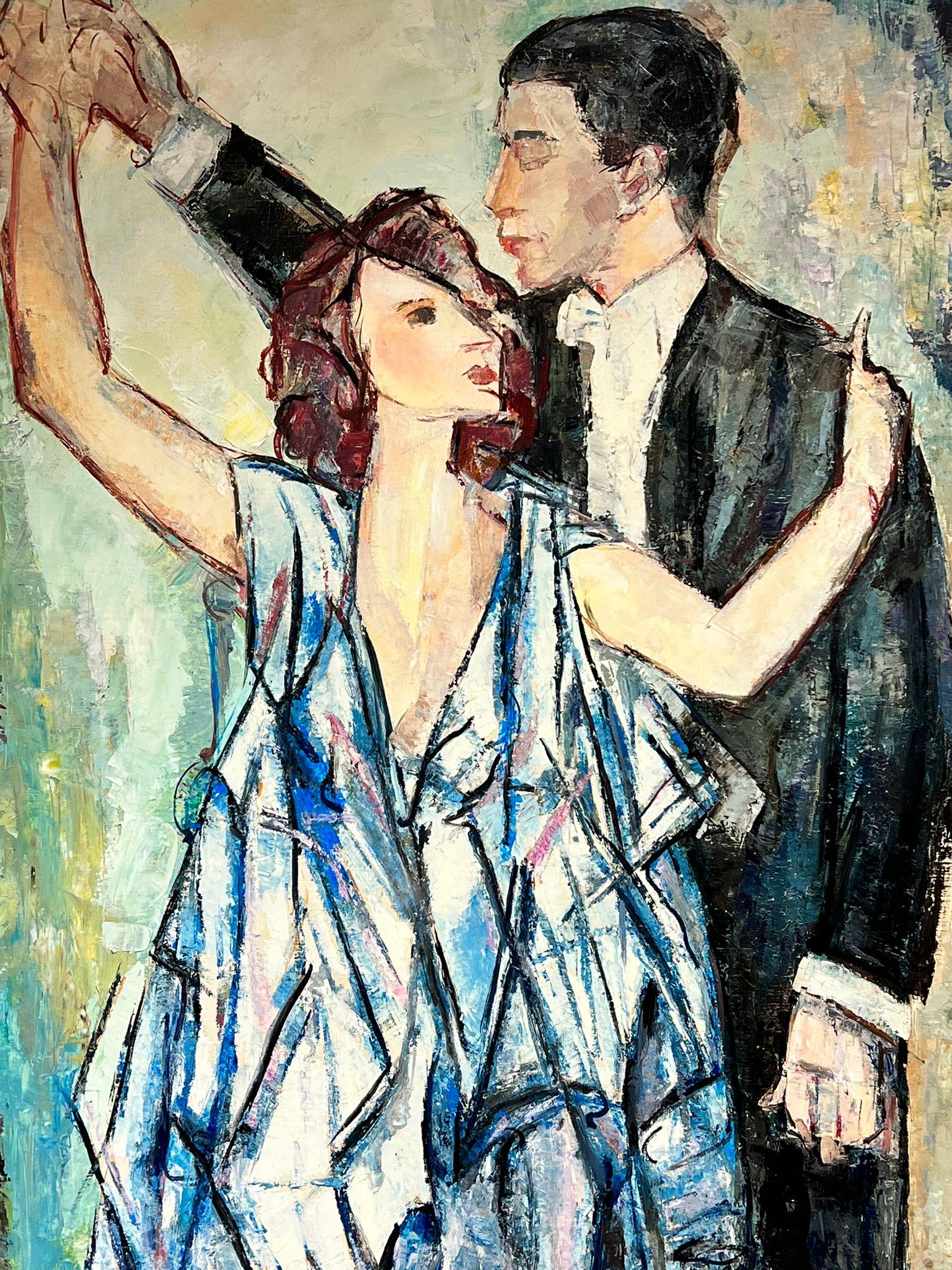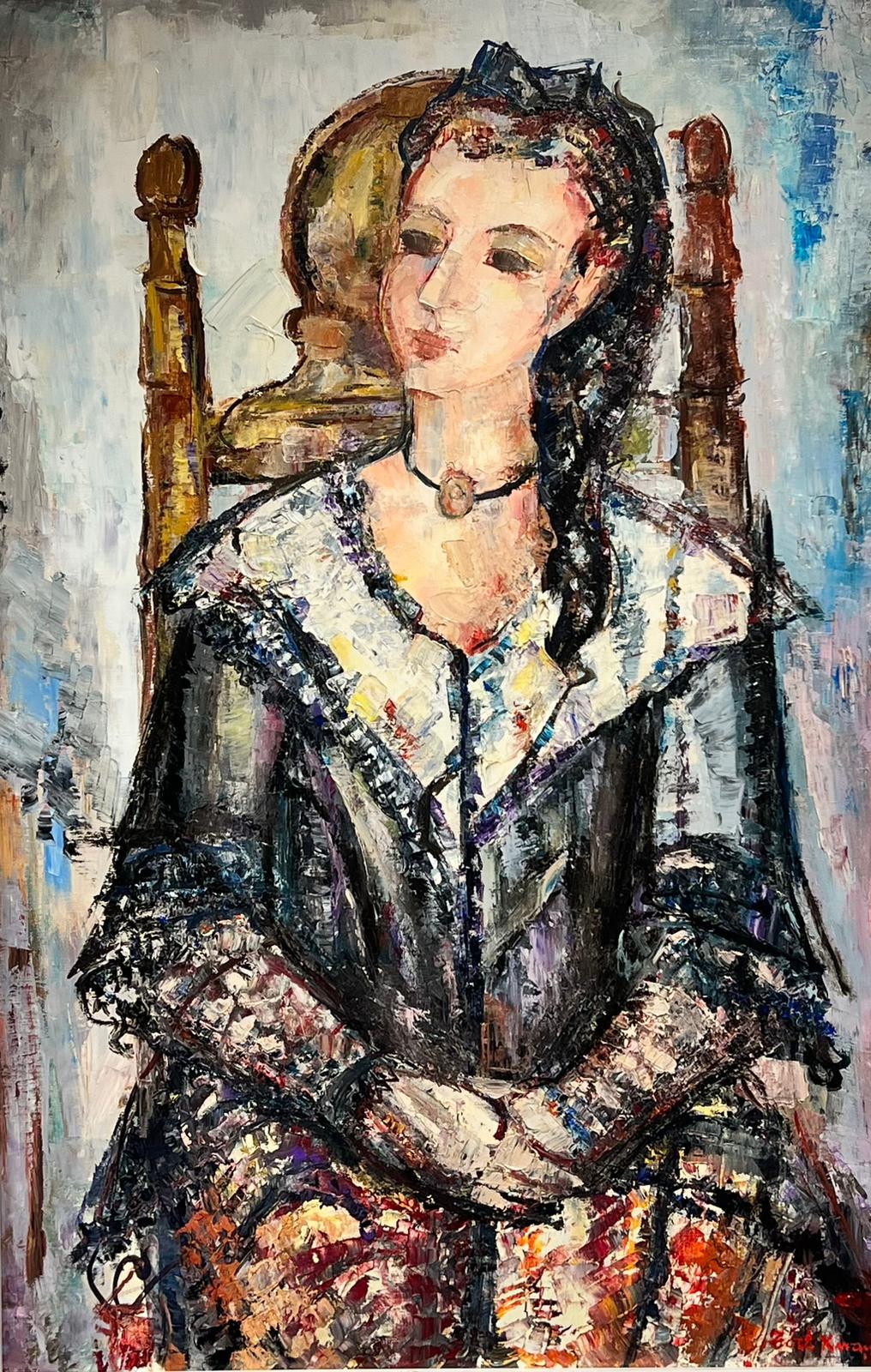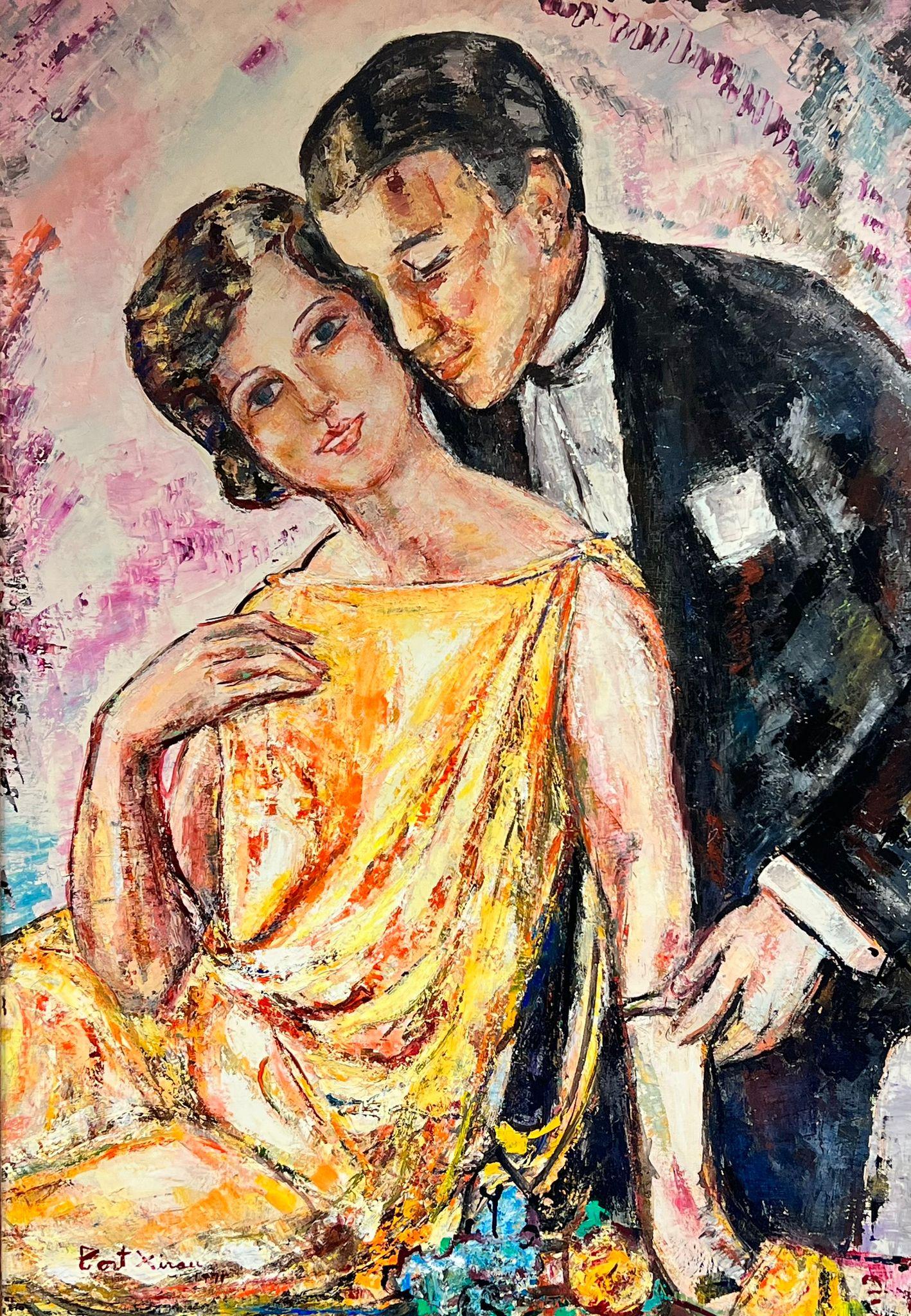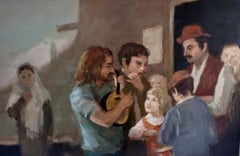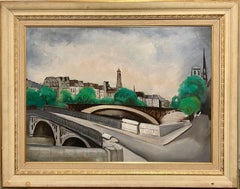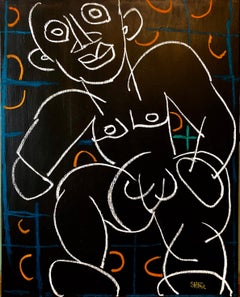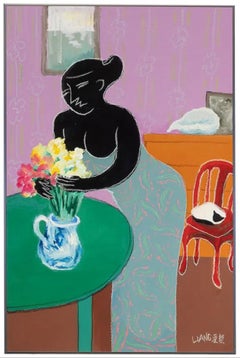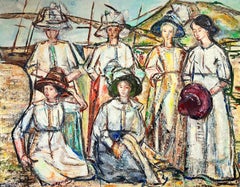Items Similar to Circus Universal, Large Modernist Oil Painting with Clown Harlequin
Want more images or videos?
Request additional images or videos from the seller
1 of 6
Stella DrabkinCircus Universal, Large Modernist Oil Painting with Clown Harlequin1952
1952
On Hold
$2,800
On Hold
£2,113.08
On Hold
€2,419.16
On Hold
CA$3,948.93
On Hold
A$4,335.43
On Hold
CHF 2,261.80
On Hold
MX$52,464.75
On Hold
NOK 28,348.20
On Hold
SEK 26,711.45
On Hold
DKK 18,058.39
About the Item
Genre: Modern
Subject: Other
Medium: Oil
Surface: Canvas
Country: United States
Dimensions: 44" x 27" x 3/4"
Dimensions w/Frame: 52" x 35"
Born (Stella) Molly Friedman to Carlaman and Francesca (Seandel) Friedman in New York City, she worked as a commercial artist before attending the National Academy of Design in New York for one year. She was married on May 1, 1926, to Dr. David L. Drabkin, later chair of the department of biochemistry, Graduate School of Medicine, University of Pennsylvania.
In the early 1930s, the Drabkins moved to Philadelphia, and Stella Drabkin became integrally involved in the art community of her adopted city. She studied at the Philadelphia Graphic Sketch Club with Earl Sorter, an illustrator known for fine etchings of cityscapes. Drabkin herself did a number of prints of street life of Philadelphia. For example, in Bargain Sale I and II, Pushcarts I and II, and Free Day at the Zoo, all from the 1930s series Old Philadelphia, she concentrated on depicting working-class, ethnic neighborhoods.
In 1933, shortly after Drabkin’s arrival in Philadelphia, she entered a painting in the Gimbel Competition. It was her inaugural exhibition outside of New York, and she was the recipient of first prize. Among other awards won over the years were the American Color Print Society Prize (1944), the Katzman Prize of the Print Club of Philadelphia (1955), and the New Jersey State Museum Purchase Prize (1967).
In an interview given in 1945 to Art Alliance Bulletin, Drabkin professed to have begun painting at the age of two. She also recalled the great pride and pleasure she felt when, in the first grade, her teacher held up her drawing for the class to admire. In the same interview she reports having no favorite medium, stating that “an artist should work in various medi[a], depending on the ideas he intends to express.”
Stella Drabkin’s work, both in process and in product, reflects a serious lifelong commitment to her art. Her career was marked by experimentation and technical innovation, particularly with the multitype. Multitypes were described by Drabkin as a development of the monotype, produced by printing multiple impressions and superimposing them one over the other, resulting in a variety of color, texture, and luminosity. Her early multitypes were made from glass plates, but by 1950 Drabkin was using plastic plates, enabling her to run first states through the etching process. Additionally, plastic plates allowed the combination of intaglio and relief methods. In the multitype process, the prints could go through twenty or more states.
Drabkin also experimented with tesserae, creating a series of mosaic panels on biblical themes. These panels are owned by the Philadelphia Free Library and were on exhibit there for a number of years. Although the art community in Philadelphia that Drabkin belonged to had a large Jewish membership, specifically Jewish subject matter is reflected in only a small portion of her work. Drabkin’s subject matter in the 1950s and 1960s included the biblical personages Enoch, Elijah, Joseph, Solomon, and David. Biblical women did not appear in this series. Drabkin also produced works titled Cabalist and Cabalist Drawings, though for the most part her work reflects the general subject interests common at the time: street life (1930s), self-portraits (1930s, 1940s), circus and mime (1950s), or nature, with haiku (1960s). Drabkin designed the 1966 UNICEF calendar. In 1969 Drabkin’s book, Prints with Poems, was published.
Stella Drabkin died on August 11, 1971. The following year, in 1972, the Stella Drabkin Memorial Award Fund was established, administered by the Art Alliance, in her honor.
Bibliography
Art Alliance Bulletin (March 1945); Collins, J.L. Women Artists in America (1973); Drabkin, Stella. Artist’s file. New York Public Library, and Philadelphia Free Library, and Print Department, Philadelphia Museum of Art; Fielding, Mantle. Dictionary of American Painters, Sculptors, and Engravers. 2d ed. (1986); Petteys, Chris. Dictionary of Women Artists (1985); Who Was Who in American Art (1985); WWWIA 6. by Beth Haber.
- Creator:Stella Drabkin (1906 - 1971, American)
- Creation Year:1952
- Dimensions:Height: 52 in (132.08 cm)Width: 35 in (88.9 cm)
- Medium:
- Movement & Style:
- Period:
- Condition:Original frame has wear and some loss. paint has some craquelure and minor scuffing commensurate with age and use.
- Gallery Location:Surfside, FL
- Reference Number:1stDibs: LU38212012062
About the Seller
4.9
Platinum Seller
Premium sellers with a 4.7+ rating and 24-hour response times
Established in 1995
1stDibs seller since 2014
1,810 sales on 1stDibs
Typical response time: 1 hour
- ShippingRetrieving quote...Shipping from: Surfside, FL
- Return Policy
Authenticity Guarantee
In the unlikely event there’s an issue with an item’s authenticity, contact us within 1 year for a full refund. DetailsMoney-Back Guarantee
If your item is not as described, is damaged in transit, or does not arrive, contact us within 7 days for a full refund. Details24-Hour Cancellation
You have a 24-hour grace period in which to reconsider your purchase, with no questions asked.Vetted Professional Sellers
Our world-class sellers must adhere to strict standards for service and quality, maintaining the integrity of our listings.Price-Match Guarantee
If you find that a seller listed the same item for a lower price elsewhere, we’ll match it.Trusted Global Delivery
Our best-in-class carrier network provides specialized shipping options worldwide, including custom delivery.More From This Seller
View AllSeymour Remenick Figurative Oil Painting "Folk Singers"
By Seymour Remenick
Located in Surfside, FL
Seymour Remenick (1923-1999) American; Philadelphia, PA. Oil on canvas painting Folk Singers and musicians.Seymour Remenick (1923-1999), was born in Detroit, Michigan and raised in ...
Category
1950s American Modern Figurative Paintings
Materials
Canvas, Oil
1927 Oil Painting Eiffel Tower Paris American Modernist Wpa Artist Morris Kantor
By Morris Kantor
Located in Surfside, FL
Morris Kantor New York (1896 - 1974)
Paris from the Ile St. Louis, 1927 (view of Eiffel Tower)
Oil painting on canvas
Hand Signed lower left.
Provenance: Hirshhorn Museum and Scul...
Category
1920s American Modern Landscape Paintings
Materials
Canvas, Oil
Rare Modernist Oil Painting Line Drawing Nude Man Louis Stettner
By Louis Stettner
Located in Surfside, FL
Signed and Dated Modern Line Drawing Oil Painting of Nude Man.
Louis Stettner (November 7, 1922 – October 13, 2016) was an American photographer of the 20th century whose work inclu...
Category
21st Century and Contemporary American Modern Figurative Paintings
Materials
Canvas, Oil
Chinese Taiwanese Modernist Oil Painting Liang Yifeng Woman in Blue Interior
Located in Surfside, FL
LIANG YIFENG (Taiwanese, born 1937),
Figure in Blue, oil and oil pastel on canvas panel,
Hand signed lower right.
Approximate dimensions - framed: 36 1/4 x 24 1/8 inches, panel: 24 ...
Category
20th Century Modern Interior Paintings
Materials
Canvas, Oil Pastel, Oil, Panel
Israeli Surrealist Judaica Abstract Oil Painting Naftali Bezem Bezalel School
By Naftali Bezem
Located in Surfside, FL
Shabbat Evening
Large Israeli masterpiece painting. Hand signed lower right
Provenance: Sara Kishon Gallery
Naftali Bezem (Hebrew: נפתלי בזם; born November 27, 1924) is an Israel...
Category
20th Century Modern Abstract Paintings
Materials
Canvas, Oil
Polish Jewish Chassidic Rabbi Judaica Art Oil Painting Konstantin Szewczenko
By Konstanty Szewczenko
Located in Surfside, FL
Konstanty Szewczenko (1910-1991), signed oil Judaica Oil Painting, Chassidic Rebbe, Polish.
Frame: 17 X 15.25
Image: 11.5 X 9.5
Konstantin Shevchenko studied at the Institute of Fine Arts in Warsaw in the years 1927 - 1928. Then, in 1932 he studied painting under the guidance of Kowarski and Pruszkowski at the Warsaw Academy of Fine Arts. Practiced easel painting, mostly judaic hassidic rabbi portraits, genre scenes. Among others, a portrait Moscicki, Rydz - Rydz, and after the war Rokossowski.He worked as a set designer. In the years 1934 - 1935 was production designer Variety Theatre. He collaborated with publishing houses with illustrations. He exhibited in Warsaw, Poland, Vienna, Austria and New York. In 1947 he took part in Exhibition Independent Artists Group) and abroad (solo exhibition at the Gallery G. Tomalsky in New York, 1964) . He is one of many great Jewish Polish artists that included Leopold Gottlieb, Maurycy Gottlieb, Henryk Hechtkopf, Leopold Pilichowski, Isidor Kaufmann, Lazar krestin, Alois Heinrich Priechenfried and Itshak Holtz. His works are in the collection of the Museum of the Polish Army. He was an Polish, Austro-Hungarian painter of Jewish themes...
Category
Mid-20th Century Modern Portrait Paintings
Materials
Canvas, Oil
You May Also Like
Large French Figurative Modernist Signed Oil Painting, Many Figures
Located in Cirencester, Gloucestershire
Artist/ School: French School, 20th century, signed
Title: Figurative composition.
Medium: signed oil painting on canvas, framed and inscribed verso.
framed: 25 x 21.25 inch...
Category
20th Century Modern Figurative Paintings
Materials
Canvas, Oil
1960's French Modernist Signed Oil Man Driving 1900's Vintage Car
Located in Cirencester, Gloucestershire
Artist/ School: Jean-Pierre Rousseau (French, b. 1939), signed and dated 1963.
Title: The Vintage Car Driver
Medium: signed oil painting on canvas, framed and inscribed verso.
f...
Category
Mid-20th Century Modern Landscape Paintings
Materials
Canvas, Oil
Huge Spanish/ French Oil Painting Elegant Ladies on the Beach Group Portrait
Located in Cirencester, Gloucestershire
The Group Portrait
by Maria Tort Xirau (Catalan, 1924-2018)
signed lower corner
dated 1991
oil painting on canvas, framed
canvas: 42 x 52 inches
framed: 33 x 43 inches
Very good condition.
Provenance: from the artists estate, France
Maria Tort Xirau ( Figueres , 26 May 1924 – 6 June 2018) was a painter and photographic and cinematographic editor from Emporda. She developed a long professional career in leading photographic studios, in films for The Walt Disney Company and also in advertising claims for companies such as Educa Borràs . The second half of her life was dedicated to painting, exercising a luminous, varied and nostalgic chromatic style in the techniques of oil and watercolor and with exhibitions of her work in Barcelona and Figueres. The Biographical Dictionary of Art Empordà defined Tort Xirau's work as "a painting that is characterized by the strength of the strokes, the vividness and brightness of the chromatic range and exudes mastery of the photographic technique. A mixture of nostalgia and tenderness is evident.".
Tort Xirau's paintings were exhibited in the two towns where she spent her life: in 1992 she exhibited his work at the Caixa de Figueres Exhibition Hall. Two years later, she did it at Sala Conex in Barcelona and in 2007 and 2013 the Consortium of Sant Ferran Castle and the Figueres Town Council organized tribute exhibitions. In 2013, she ceded to the council of the city of Figueres her work Mercat de la plaça de l'Ajuntament , watercolored on paper around 1991, which is exhibited in the rest room of the building.
On June 6, 2018, she died in Figueres at the age of 94, receiving the apostolic blessing . Two years after her death, part of her paintings were included in the exhibition Paint, create, live. Women artists in the Alt...
Category
1990s Modern Figurative Paintings
Materials
Canvas, Oil
Huge Spanish/ French Oil Painting - Baby blue couple
Located in Cirencester, Gloucestershire
The Dancers
by Maria Tort Xirau (Catalan, 1924-2018)
signed lower corner
dated 1999
oil painting on canvas, framed
canvas: 36 x 55 inches
framed: 41 ...
Category
1990s Modern Figurative Paintings
Materials
Canvas, Oil
Huge Spanish/ French Oil Painting Girl Seated in Chair
Located in Cirencester, Gloucestershire
Portrait of a Lady in a Chair
by Maria Tort Xirau (Catalan, 1924-2018)
signed lower corner
dated 1991
oil painting on canvas, framed
canvas: 47 x 37....
Category
1990s Modern Figurative Paintings
Materials
Canvas, Oil
Huge Spanish/ French Modernist Oil Painting Elegant Couple in Tender Embrace
Located in Cirencester, Gloucestershire
The Embrace
by Maria Tort Xirau (Catalan, 1924-2018)
signed lower corner
dated 1991
oil painting on canvas, framed
canvas: 42 x 29.5 inches
framed: 4...
Category
1990s Modern Figurative Paintings
Materials
Canvas, Oil
More Ways To Browse
Girl In Blue
Marvel Art
Vintage Rodeo
A Vogel
Dutch Paintings Old Master
Expressionism Portrait
Absolut Vodka
Hyper Realistic Paintings
Oil Paintings Of Music Instruments
19th Century Figurative Paintings Dance
Antique Paintings Mythological
Dior 1947
Emmanuel College
King David
Nicolas Oil Paint
Paintings Children Playing
Prado Museum
Saffron Art
